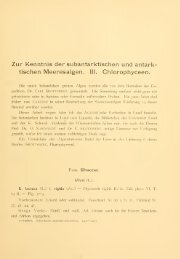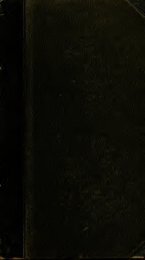Download PDF
Download PDF
Download PDF
You also want an ePaper? Increase the reach of your titles
YUMPU automatically turns print PDFs into web optimized ePapers that Google loves.
64<br />
ZYGNEMATACEAE<br />
soils, rocks, and bogs. From there they are sometimes carried into<br />
streams and ditches by rains, and continue to grow in the water<br />
medium.<br />
In Zygogojiinm encetorum there is a strong tendency toward<br />
encystmcnt whenever habitat conditions change; this is true even<br />
of the gametes. The gametes may be walled off in the conjugating<br />
papillae before the solution of the wall between the papillae. Sub-<br />
sequently this wall may be dissolved and the gametes may unite.<br />
This was the mode of reproduction first seen and described by<br />
de Bary (1858). Subsequently normal reproduction was described<br />
by the Wests (1894), t>ut in 1918 Hodgetts found and described<br />
the reproduction by encysted gametes and insisted that this is<br />
the normal process. In 1933 Transeau published figures show-<br />
ing both modes of conjugation in the same pairs of filaments.<br />
Since none of the other species exhibits so-called secondary gametangia,<br />
these must be regarded as a peculiarity of Z. encetorum,<br />
and direct conjugation the normal procedure.<br />
The taxonomic characteristics of the genus Zygogonium may<br />
be summarized as follows:<br />
1. The species are terrestrial or amphibious on acid substrates.<br />
2. The filaments may become branched, sometimes with horizontal<br />
filaments on the soil and erect branches arising from them.<br />
3. Reproduction by akinetes and aplanospores is common. All the<br />
vegetative cells of some filaments may be changed to these structures.<br />
4. Reproduction by zygospores is apparently infrequent, and the<br />
zygospores are enclosed in a sporangium wall with an equatorial suture.<br />
5. Cytoplasmic residues are present in sporiferous and gametangial<br />
cells after spore formation.<br />
6. Cell walls and cell contents are often colored purple, and in terrestrial<br />
specimens the cell walls may become very thick, opaque, and<br />
yellow or brown.<br />
7. Accumulation of fat globules and starch in terrestrial specimens<br />
often obscures both the nucleus and the chromatophores.<br />
Key to the Species or ZYGOGONIUM<br />
I. With aplanospores only (zygospores unknown) 7<br />
1. With zygospores (sometimes aplanospores also) 2<br />
2. Median spore wall smooth 3<br />
2. Median spore wall not smoodi, yellow to brown 4<br />
a- Median spore wall not smooth, blue 13. Z. indicum




